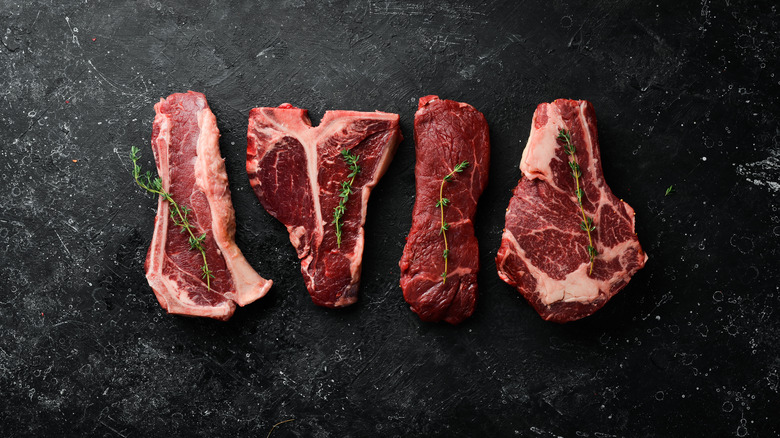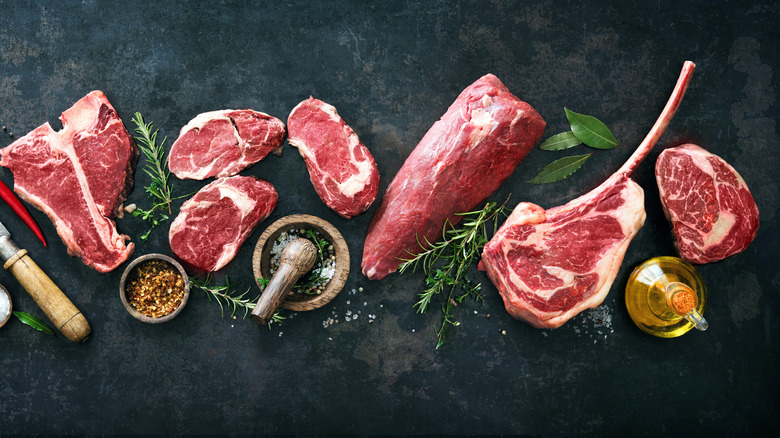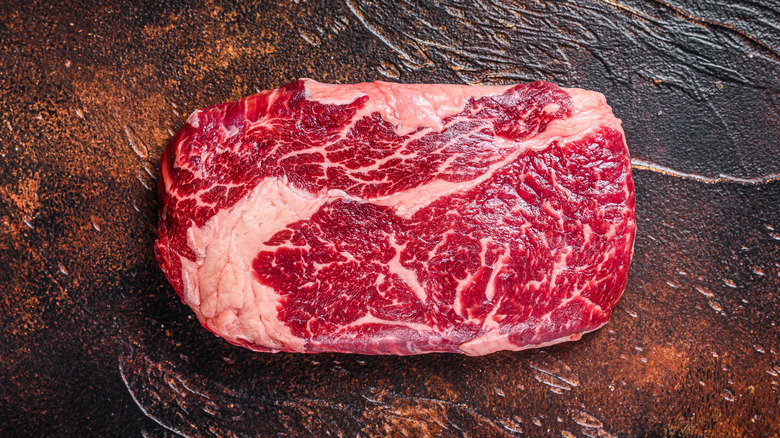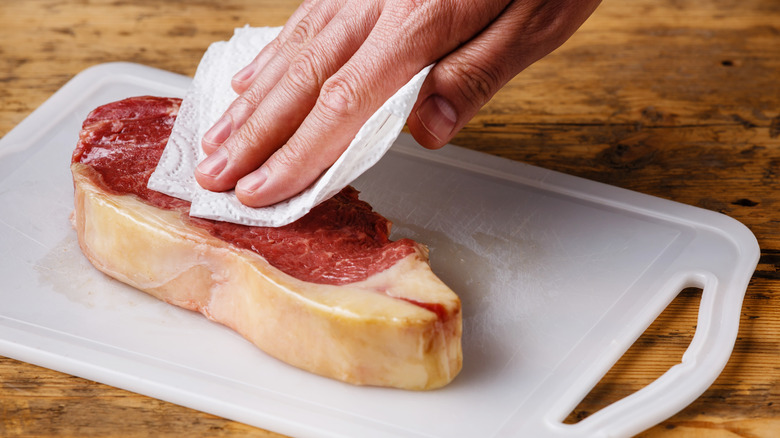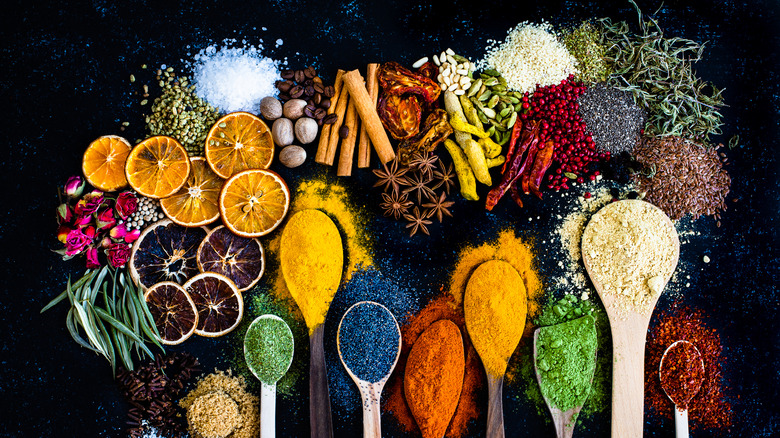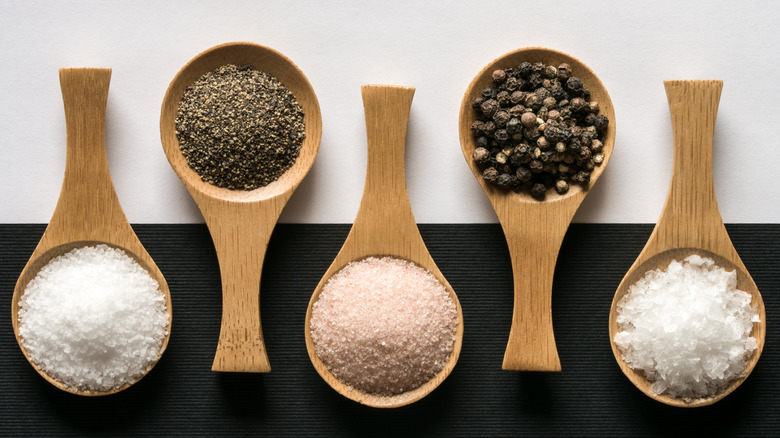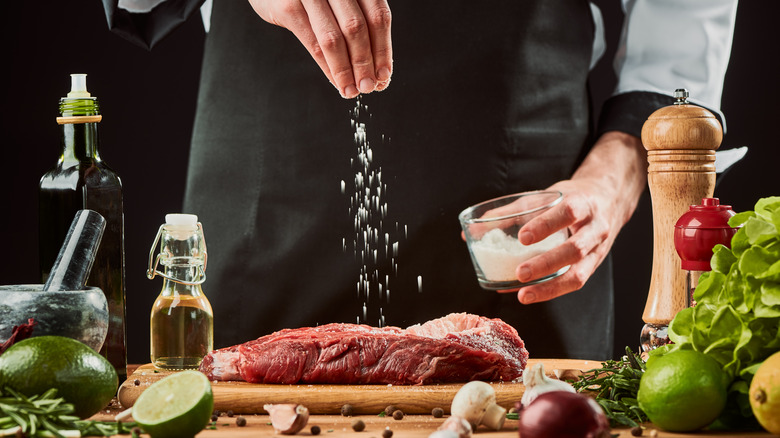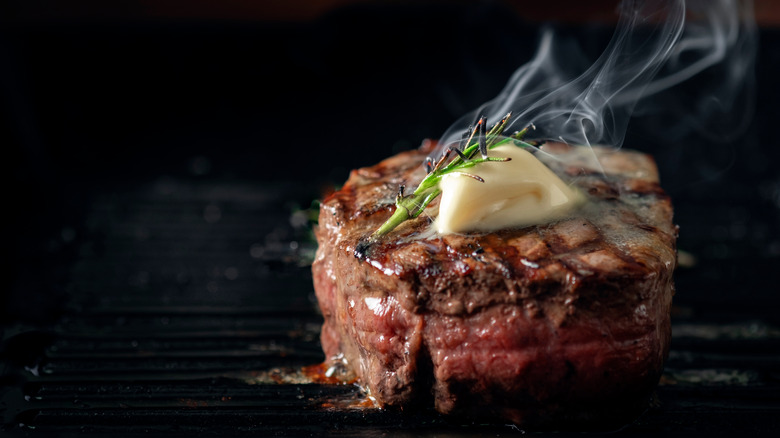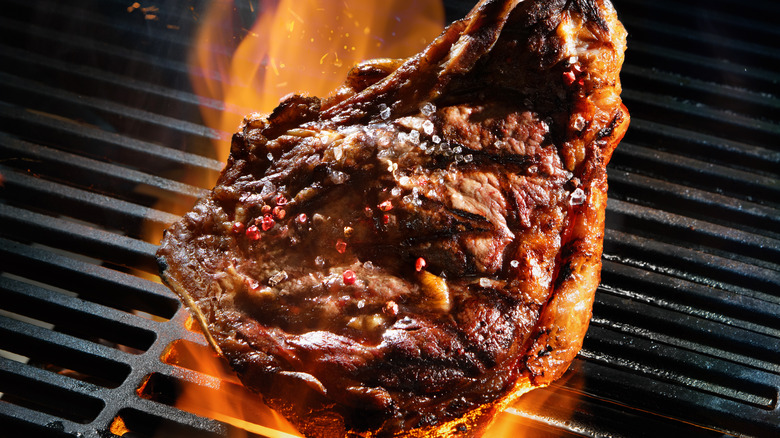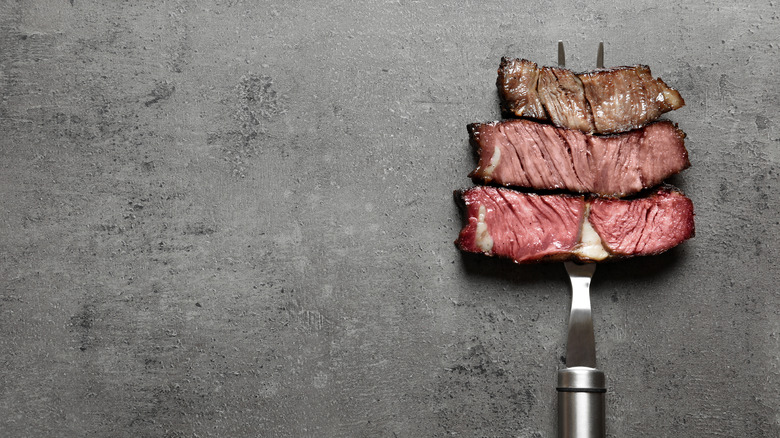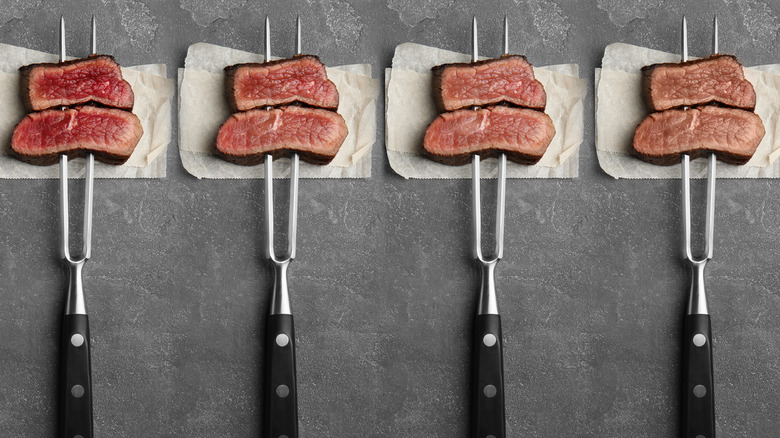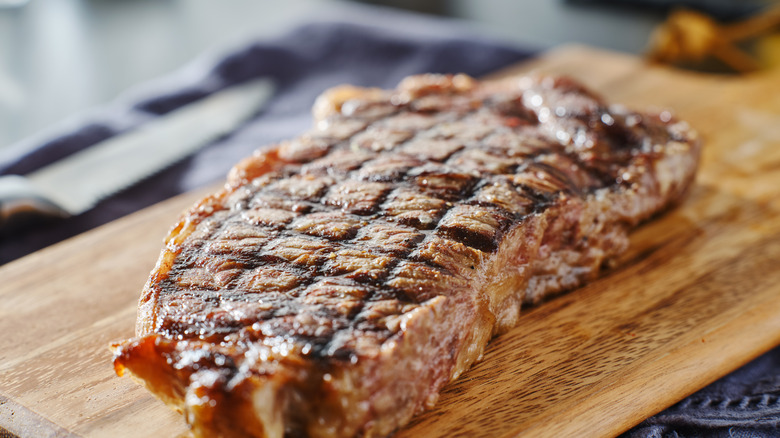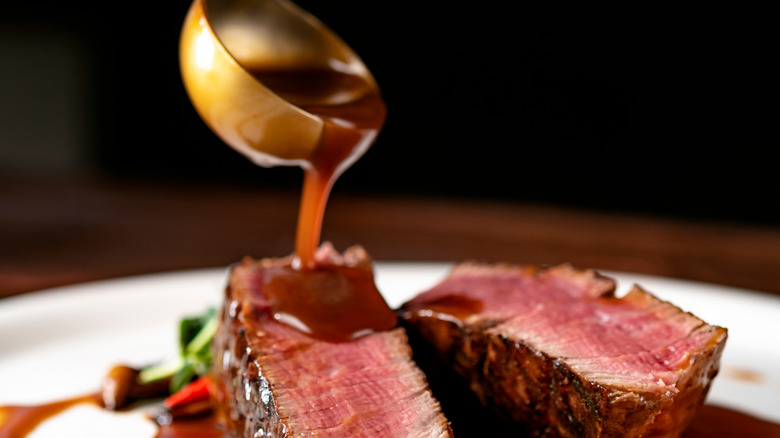13 Big Mistakes You're Making With Steak
If you're a meathead who's got major beef with paying steakhouse prices, we get it. And we've got a solution! Cook your steak at home.
Look, we get it. It can seem intimidating to make that perfect charred on the outside, tender and juicy on the inside steak in a home kitchen, especially given the cost of truly great prime steak. Not a load of margin for error, there! And who hasn't been disappointed when they pulled their steak out of the pan to find it grey on the outside and dry within?
Luckily for you, your days of ho-hum at-home steak experiences end now. We've got loads of tips to help achieve steak greatness from the comfort of your own kitchen — and they all begin with common errors. Look no further, friends: These are the most common mistakes you may be making when cooking your steak at home, and how to fix them.
1. Assuming all steaks are the same
Mistake number one is assuming that picking up a "steak" is a simple task! Steaks can be broken down into a number of categories, each of which has its unique characteristics.
The first defining factor is the cut, aka what muscle you're cooking. Cuts like filet mignon, which are tender and have less fat, will be less forgiving of overcooking than flavorful, marbled cuts like ribeye or New York strip. Others, like flank steak or skirt steak, are happiest marinated and grilled before being thinly sliced against the grain to reduce chewiness (via The Spruce Eats).
Steaks may also boast one of several USDA grade shields — Prime, Choice, or Select — with Prime coming out on top with the most abundant marbling, and Select being the leanest and demanding the most care to get just right. It can be tempting for a steak novice to opt for cheaper cuts, and there's nothing wrong with them, but if you want true steak nirvana, go for Prime!
One other label you'll often find on steak packaging is related to what the cattle are fed: grass, grain, or a mixture of both. Grass-fed steaks can tend to be tougher due to a lack of fat; The Organic Butcher recommends cooking them at a lower temperature to avoid this problem. Grain-fed steaks, meanwhile, have more marbling, and the grain lends a sweeter, richer taste to the beef (via Steak University).
2. Cooking steak right out of the fridge
When you're cooking dinner on a busy weeknight, it can be tempting to pull your steak right out of the fridge and get to work, but some experts caution against this, noting that a quality steak truly shines when it has some time to get to room temperature. Jamie Oliver recommends a full hour on the counter, noting that cooking steak from fridge temp will keep it from cooking evenly. The recommendation is echoed by experts like Thomas Godfrey, chef and food operations manager at The Meat & Wine Co in Sydney, who tells Steak School that not only will cooking a room temperature steak lead to a more evenly cooked final result, but it will also keep the muscle fibers from tensing up, paving the way for a more tender texture throughout.
While these are compelling arguments, for other experts, this rule is actually no more than legend. Barbecue expert Hank's True BBQ busted this myth on his YouTube channel, recommending, instead, the reverse sear method, which, according to Serious Eats' J. Kenji López-Alt (who also pooh-poohs bringing steaks to room temperature in an article for Cooking Light) consists of cooking the steak in a low oven before finishing it over high heat in a "ripping-hot" skillet or on a hot grill.
3. Neglecting to pat your steak dry before cooking it
The best steakhouse steaks boast the most delicious of contrasts. You know the one: a tender, juicy interior juxtaposed against that beautifully crisp, charred exterior. To get that same perfect balance at home, you've got one nemesis: moisture. Water is the enemy of the Maillard reaction that makes a seared steak so delicious. Any residual moisture glistening on the outside of the steak when you remove it from its plastic or butcher paper will cause it to steam rather than sear, resulting in a crust that's far grayer and way less crispy than you might have hoped for.
Indeed, for Cooking Light, one of the most important factors in cooking a great steak is how dry it is before it goes into the pan. Blotting the outside of the steak with a paper towel may seem like a small thing, but according to the outlet, it's an unskippable step in taking your steak from just fine to wow-worthy.
4. Over-seasoning your steak
A truly good steak should speak for itself; adding too many competing flavors will drown out the beef. Indeed, says Lachlan Graham, a fourth-generation cattle farmer from New South Wales, Australia, "There's nothing better than to let the natural flavours of the meat sing" (via Steak School)
Graham recommends a simple seasoning of olive oil and coarse salt; a scattering of black pepper can join the flavor team only when the steak has emerged from the pan. This may seem like a bold suggestion, but the experts at LifeHacker, too, suggest separating the seemingly inseparable seasoning pair. Seasoning with salt before cooking and pepper after both keeps the steak from being bland and solves the issue of the pepper burning in the hot skillet, thus becoming bitter. No one wants a bitter steak!
That said, according to The Spruce Eats, adding pepper after cooking introduces a whole different problem: The pepper might fall off the surface of the steak. The outlet notes that while this problem can be mitigated by passing a pepper grinder around at the table, it's also fine to season your steaks with pepper before cooking, so long as you haven't noticed a burnt flavor on your steaks in the past.
Either way, anything more complicated than simple salt and pepper risks overwhelming the flavor of the steak itself, so resist the urge to open the spice cabinet for anything else.
5. Under-seasoning your steak
When it comes to the number of seasonings you choose for your steak, less is more. But when it comes specifically to salt, more is more! Bon Appétit points to salt as the main reason why restaurant steaks are so often superior: Many home cooks, the outlet claims, are afraid of adding the aggressive amount of salt needed to make a steak really sing.
As for how much that should be exactly, Bon Appétit recommends a coating that makes the steak look like it's wearing a skin-tight t-shirt — a far from scientific but totally evocative depiction of what could appear to be a lot of salt. But the recommendation checks out! According to The Spruce Eats, the outside needs to be almost too salty to compensate for the fact that you can't actually season the inside of the steak.
If you need more guidance than this beautiful but perhaps opaque metaphor, the pros at Clover Meadows Beef recommend ¾ teaspoon to a teaspoon per pound of beef, evenly applied on all sides and preferably scattered from up high, which allows for more even dusting.
6. Seasoning with the wrong kind of salt
How much salt you use is just the beginning of the steak seasoning puzzle. The kind of salt you use is just as essential, if not more so. Salt, after all, comes in many different forms, from kosher salt to table salt to flaky sea salt. Each type of salt has its own perfect application.
According to Bon Appétit, a good steak starts with kosher salt, as the coarser grains absorb well into the raw steak's outer layer. After this first liberal seasoning — and a hot sear — Bon Appétit recommends a second round of seasoning with salt of the flakier variety, like Maldon sea salt. This crunchier salt is aptly dubbed a finishing salt, and it should be applied only after the steak is cooked.
This is also your opportunity to impart a slightly different flavor to the steak, should you choose to. Pete Balistreri, Chef and Vice President of Tender Greens Stores, tells Eat This, Not That that opting for smoked or spiced finishing salt gives your steak an added edge. Consider using flaky salts infused with herbes de Provence, coffee, or even black truffle to add even more flavor to your steak!
7. Seasoning the steak at the wrong time
Just as important as how much you season your steak is when you season it. Some chefs say that you should season steak the moment before it goes into the pan, seeing as salt pulls moisture out from the inside of the steak, making the outside layer damp and thus contributing to the possibility that it may steam rather than sear. Indeed, the Spruce Eats notes, seasoning too far in advance may result in a drier steak overall, and Thomas Godfrey, chef and food operations manager at The Meat & Wine Co in Sydney tells Steak School that specifically with smaller steaks, salting too early can cause your meat to begin to cure, which makes it tougher to get a beautiful outer crust on it.
But other experts say that you can use this quirk to your advantage. Per Cooking Light, salting a steak at least 40 minutes in advance of cooking will allow the steak the time not only to release moisture but also to reabsorb it, for a dry outer surface and a seasoned interior — and things get even better if you season a full day in advance. For more on the science of steak seasoning, this deep dive from Serious Eats is required reading!
8. Cooking your steak in the wrong fat
Butter certainly adds flavor to steak, but it's far from the best cooking fat, according to experts. This is due to the relatively low smoke point of butter — which, according to Serious Eats, is a measly 350 degrees Fahrenheit (aka not nearly enough to get you that beautiful sear you crave). Even if you graduate to clarified butter or ghee, you're still only at 450 degrees. Refined oil is best for searing, with a smoke point of up to 510 ºF for safflower oil.
Yet another option is beef tallow, which adds to the beefiness of your steak(via ByTable Foods). It has a slightly lower smoke point than oil, 420 degrees, aka a comfortable medium-high to high heat. Because of this, you may have to compensate for the added flavor with a slightly lower flame.
Whichever fat you use to sear your meat, Serious Eats recommends finishing with butter a minute or two before you remove the steaks from the pan. This will allow you to add buttery flavor to the beef without burning it. The best of both worlds!
9. Cooking steak at too low a heat
If the choice of fat for cooking a steak is such a point of contention, it's in large part because in order to cook the perfect steak, you need to cook it at a seriously high heat. Cattle farmer Lachlan Graham tells Steak School that most restaurants cook at such a high heat that you may not be able to replicate it at home without setting off the smoke alarm. The flavor may be worth the noise, however, as full blast is where it's at.
"Don't be scared to give the steak some heat," he says. "You should hear your steak sizzle when it hits the pan."
The Spruce Eats agrees, noting that it's important to get your flame (or pan) to "the highest heat you can generate." This, the outlet explains, will cook your steaks through faster, which translates to a tender interior and a beautifully charred outer crust. A lower temperature may give you a grey exterior and dry interior — far from the most appetizing steak.
10. Overcooking your steak
Is there a greater crime than taking a beautiful, marbled piece of steak and cooking it until it's as dry, tough, and gray as shoe leather? We think not. Jay Rayner, writing for The Guardian, argues that ordering well-done steak is worse than a misguided food preference: It's a high culinary crime.
Whether you agree with Rayner's admittedly judgmental stance, for Jamie Oliver, the facts are clear: Anything more than medium translates to tough steak, something that the experts at Napoleon note stems from the fact that the longer steak hangs out over high heat, the more of its natural collagen contracts, squeezing out the juices and leading to a steak as tender, they say, as old army boots.
Overcooking steak is more than just a question of flavor. According to the National Institutes of Health, overcooking meat, or cooking it at high temperatures, can produce carcinogenic substances like heterocyclic amines. It's best to stay on the safe side: medium-rare is where it's at.
11. Cutting into steak to check its doneness
With so much riding on the line in terms of perfect cooking temperature, it may be tempting to cut into your steak to see if it's done. Serious Eats counsels against it ... but perhaps not for the reasons you may think.
Popular mythology surrounding the perfect steak seems to indicate that piercing a steak with a fork — or cutting into it with a knife — is a folly that will have it leaking juices all over the place (juices that you'd much rather have in your mouth than on the plate). But after testing this popular myth for veracity, Serious Eats found that piercing the steak does not actually cause it to lose moisture. Huzzah!
There is a more important issue with cutting into a steak to see if it's done, however: that of accuracy. Steak in the pan will look a lot rarer than it will on the plate because carryover cooking will increase the steak's temperature even after it leaves the pan. Instead of cutting into it to see if it's done, follow Serious Eats' advice and invest in a digital thermometer.
12. Not resting the steak before slicing and serving
Your hard work has paid off, and it's time to pull that beautiful, charred, glistening steak from the pan. It may be all you can do not to dig right in ... but please, restrain yourself! Allowing the steak to rest after cooking is an essential element of ensuring that it's as tender and juicy as possible.
As a steak rests, explains Serious Eats, the muscle fibers, which will have contracted during the cooking process, relax; this allows them to hold onto more liquid. The outlet found through testing that a steak that has rested just five minutes boasts a world of difference in terms of juiciness compared to a steak cut into right after it comes out of the pan. If you can wait for ten, that's even better.
Of course, in that resting time, the steak is also carryover cooking, so you need to adjust your cooking time accordingly. Per Certified Angus Beef, steak temperature will increase about 5 degrees as it rests, which is why it's essential to pull it off when it's just a bit underdone for the ideal final result.
13. Not taking advantage of pan drippings
While your steak is resting, you have one more opportunity to create more flavor. Instead of washing out the pan, use those delicious pan drippings for the perfect sauce. By adding liquid to deglaze your pan, you can bring up all of that crispy, caramelized fond and turn it into a phenomenal sauce to drizzle over your perfectly seasoned and cooked steak.
Pan sauces, according to Serious Eats, can range from the simple to the complex. For a quick fix, just add beef stock or water to the pan (after pouring off any excess fat, of course), and reduce the liquid over medium-low heat. Emulsify in a knob of butter, and voilà: pan sauce.
If you're willing to let things get even slightly more complicated, you could also start with a base of aromatics, like shallot, onion, or garlic, which will cook in the residual fat and provide even more flavor. You could also use a combo of liquids, beginning with wine (perfect for deglazing) or cognac (best flambéed to cook off the excess alcohol) and finishing with cream, which will make the sauce luscious, rich, and impossible to resist.
